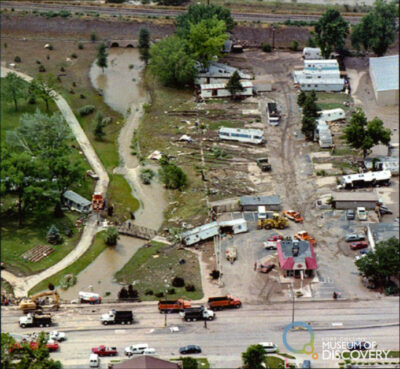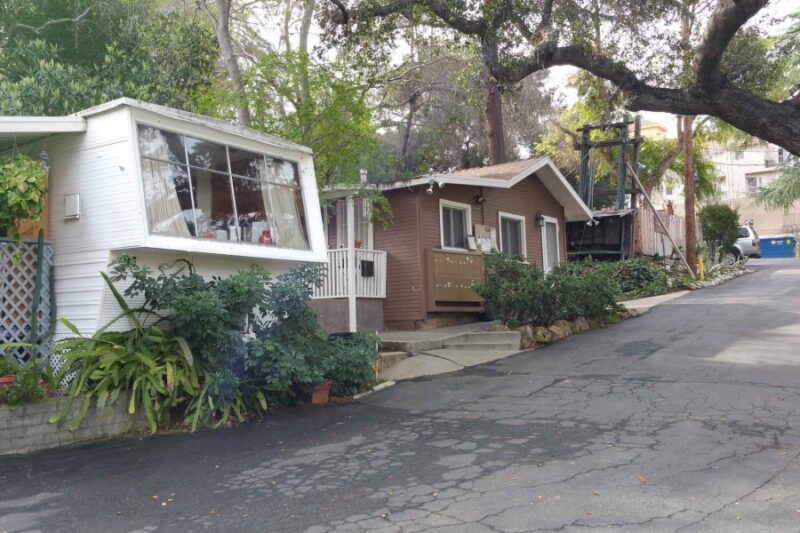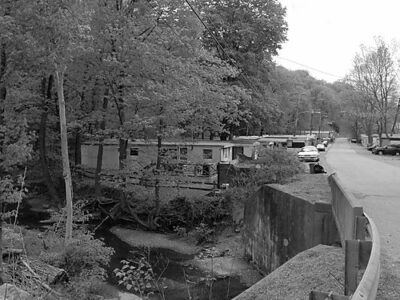Mobile Roots: The Case for Trailer Park Preservation
12 June 2024 – Dalena Collins
In 1997, my hometown of Fort Collins, Colorado, was ravaged by a flood. During the deluge, the Johnson Center Mobile Home Park was completely destroyed. As a young child, I walked through the empty lot where the homes used to sit and wondered about the community that had been erased.

Aerial photograph showing damage done to Johnson Mobile Home Park after the flood of 1997. Photo credit: Fort Collins History Collection.
According to the U.S. Census, over 20 million people in the United States live in trailer parks. Manufactured homes have been an integral part of American housing for over a century, but the impact of these communities has been overwhelmingly ignored or forgotten by historians, city legislatures, and citizens. The field of historic preservation has a unique opportunity to recognize and preserve these historic places. Trailer parks not only qualify under Criteria A and C of the National Register of Historic Places (NRHP), but they also qualify under a multitude of city requirements.
The first trailer park dates to 1913, and the advent of trailers grew directly out of the proliferation of the automobile in the early twentieth century. To enjoy more of the comforts of home while on the road, auto campers began to attach storage to their cars. By the late 1930s, the Durham house and other mobile/manufactured homes hit the market. Leading historians highlight the fact that manufactured homes experienced an enormous rise in popularity during the Second World War. In 1940, the U.S. government ordered 1,500 mobile homes, and by 1945 it had ordered 150,000 more. The postwar period also saw an increase in the number of dedicated neighborhoods for trailers, from 820 in 1945 to over 3,000 in 1953. Throughout the late 20th century, the use of trailers shifted. For young couples aspiring to home ownership on a tight budget, trailers were the perfect compromise. Unfortunately, because of their affordable nature, they also facilitated the movement of white people out of urban areas that had larger minority populations, a process sometimes called “white flight.”
While no one would argue that mobile homes are as visually impressive as a Queen Anne, style is not the only consideration in determining architectural significance. Trailer homes are defined as a structure that is manufactured elsewhere and assembled on site. Almost always, they include a chassis that facilitates movement. Because of this, the appearance of mobile homes was never the focus of their design. Instead, the appearance becomes a consequence of efficiency, mobility, and cost effectiveness. Moreover, while trailers are often seen as temporary structures, about 90% never move from their original build site.

Monterrey Trailer Park is the only trailer park in the United States with historic designation. Photo credit: Louisa Van Leer Architecture, Los Angeles City Planning.
Both the historic associations and architectural innovations of trailer parks are sufficient for many of these sites to qualify for the NRHP. However, local designations are usually quicker and more accessible. The only trailer park that has been recognized in the United States is Monterrey Trailer Park in Los Angeles, California. In a historic context statement, the city cited its association with travel and immigration in the area as the rationale for its designation.
As we see a massive housing crisis take shape in the United States, trailer parks have an integral role to play. In her book Manufactured Insecurity, Esther Sullivan explores the continually rising number of mass evictions that trailer park residents are experiencing. The systematic shutting down of trailer parks is a symptom of the shift from public control of affordable housing to private control. It is common for cities to impose ordinances on trailer parks that become prohibitive for residents and owners, making it easier for developers to purchase the land. Forbes magazine states that only about ten new trailer parks were built between 2010-2020 and about the same number are torn down each year. Trailer parks are being commodified in a way that not only victimizes people currently living in the parks but also eliminates an option for affordable housing moving forward. As parks disappear, we lose the resources to study them and the role they have played in American history.
So many of the difficulties that trailer parks and their residents face stem from deep-seated stigmas. Many scholars think that these negative associations originated during the Great Depression. This time period marks the separation of trailers as tools for leisure and trailers as housing. Since then, these views have only deepened. The view that mobile homes are disposable and temporary provides a level of justification socially, economically, and politically for people to marginalize entire communities. This stigma is at odds with what trailer parks can provide. Trailer parks are a good option for affordable housing because they are cheap, they provide residents with outdoor space, and they create a sense of community.

Brookside Mobile Home Park, 2006. Photo credit: Louis A. Chandler, Monroeville Historical Society Collection, Historic Pittsburgh.
But what is the best way to help current residents? The reality is that no one thing is going to solve this issue, and any approach to the problem must be multi-faceted. The establishment of new zoning laws and other legislation will have the most direct impact on trailer-park living. For example, a city in Colorado is moving six of its parks to a new, historically-minded zoning code which would make redevelopment more difficult. Historic preservation projects would have a less direct result; however, they hold an important place in this multi-faceted approach. The Brookside Mobile Home Park in Monroeville, Pennsylvania, is the perfect example of a park that could qualify for local or even national designation. Brookside has existed since the 1940s. The original layout of the park remains unchanged and has been owned by a local businessman for over sixty years.
Historic designation would provide recognition of these spaces that may also empower residents to advocate for themselves and the communities they live in. The field of historic preservation works to recognize “places worthy of preservation.” By advocating for manufactured homes, historic preservationists will take the first step in battling this deeply held stigma.
About historic places, preservationist Stephanie Meeks says, “they help us understand that the lives we lead are not insignificant–that what we do will have an impact on the future.” Trailer parks are not insignificant, and their residents need to know that their impact matters.
~Dalena Collins is a recent graduate of the Duquesne University Public History program. She hopes to continue exploring the relationship between historic preservation and low-income housing and currently works in the education department of the Frick Pittsburgh.




Great work Dalena. Interesting and very educational. Thanks for the insight.
Fabulous and incredibly important research.
Dalina, this is excellent work. Yes, absolutely trailer parks are cultural landscapes, related to migration and immigration as well as labor, class, and so much more. I wrote a book about shantytowns and if I had kept going the next chapter would have been about trailer parks. Great topic! Maybe interesting to consider the different cultural attitudes toward RVs (owned and operated by middle class) as opposed to trailers? I’m also thinking of a great article a colleague of mine, Susan Fraiman, wrote about the move “Nomad.”
At the City of Venice, FL, we are currently in the process of designating the clubhouse at our municipal mobile home park to the local register. While I did elaborate on its role with the mobile home park (and it’s a fascinating story of a communal space), the building is the last in situ structure from the Venice Army Air Base. The city acquired the land from the War Assets Administration in 1947 and opened the mobile home park three years later. It is still in operation. However, I would add that there was some push back about the designation in case the city wanted to redevelop the property.
As a public historian working in a low-income rural area, I absolutely love this topic and commend you for doing this important work. I’d love to learn more about any existing NRHP listings for trailer parks, as I’m sure they can serve as a model for those of us interested in pursuing designations in our own areas.